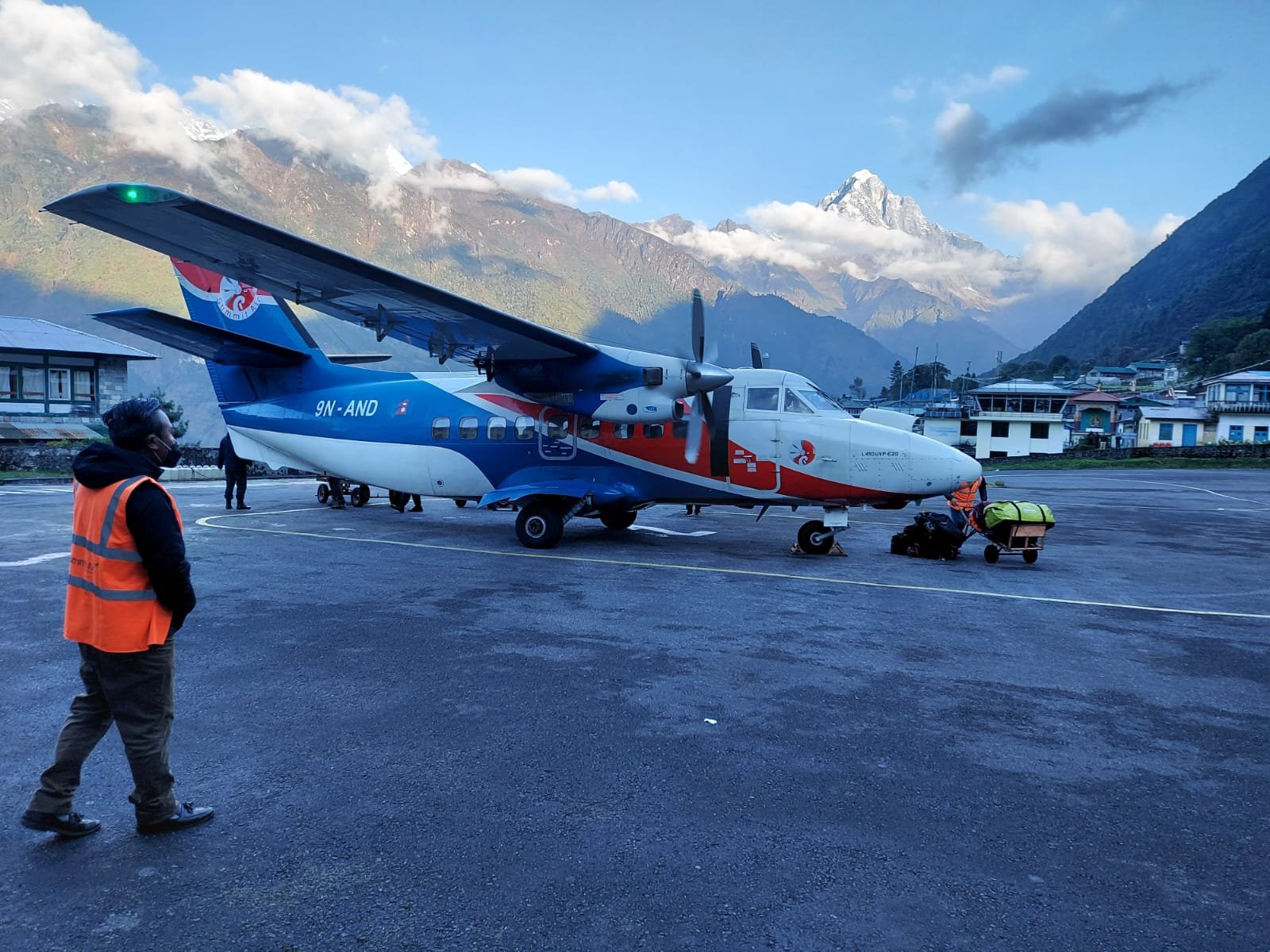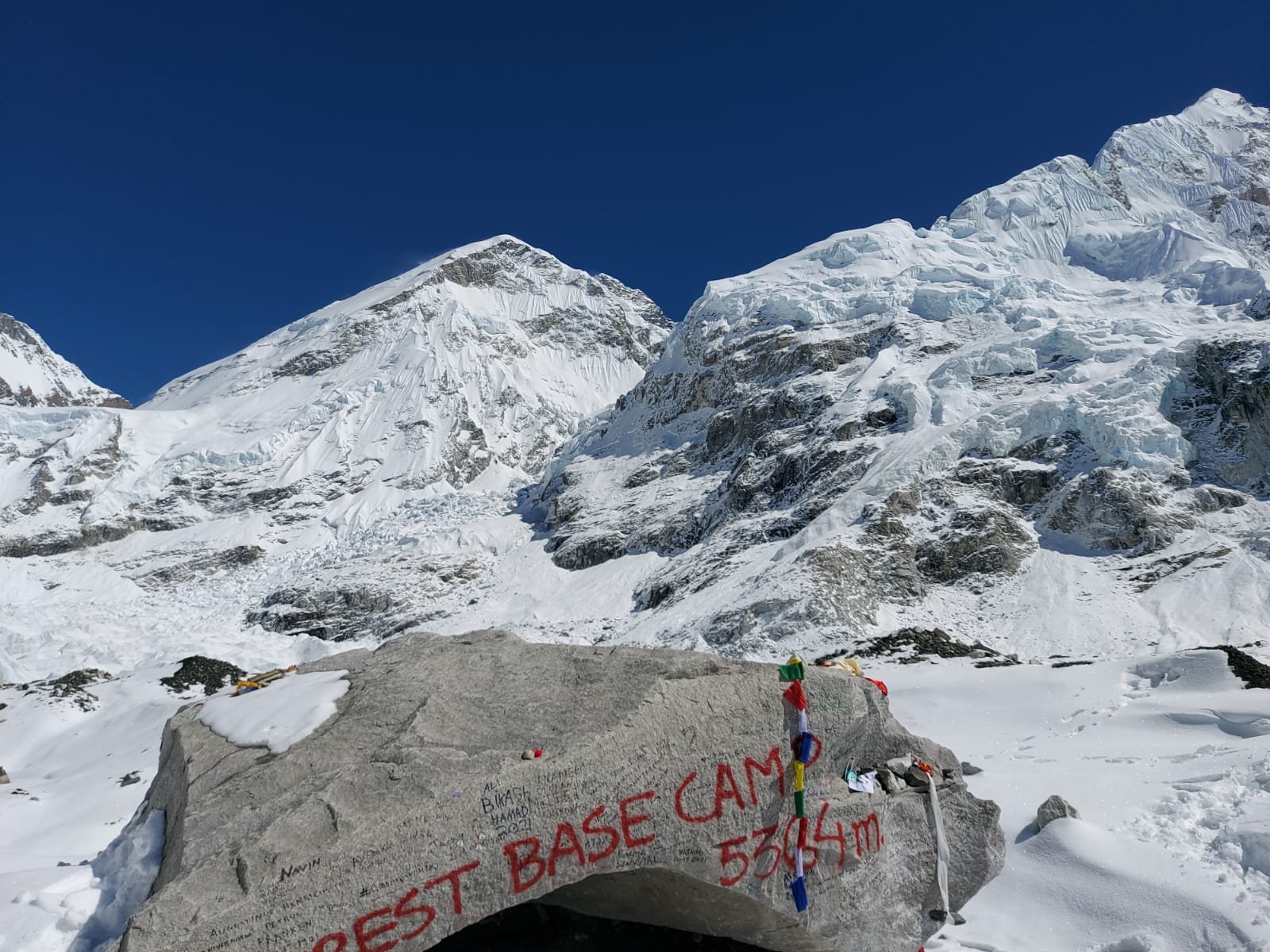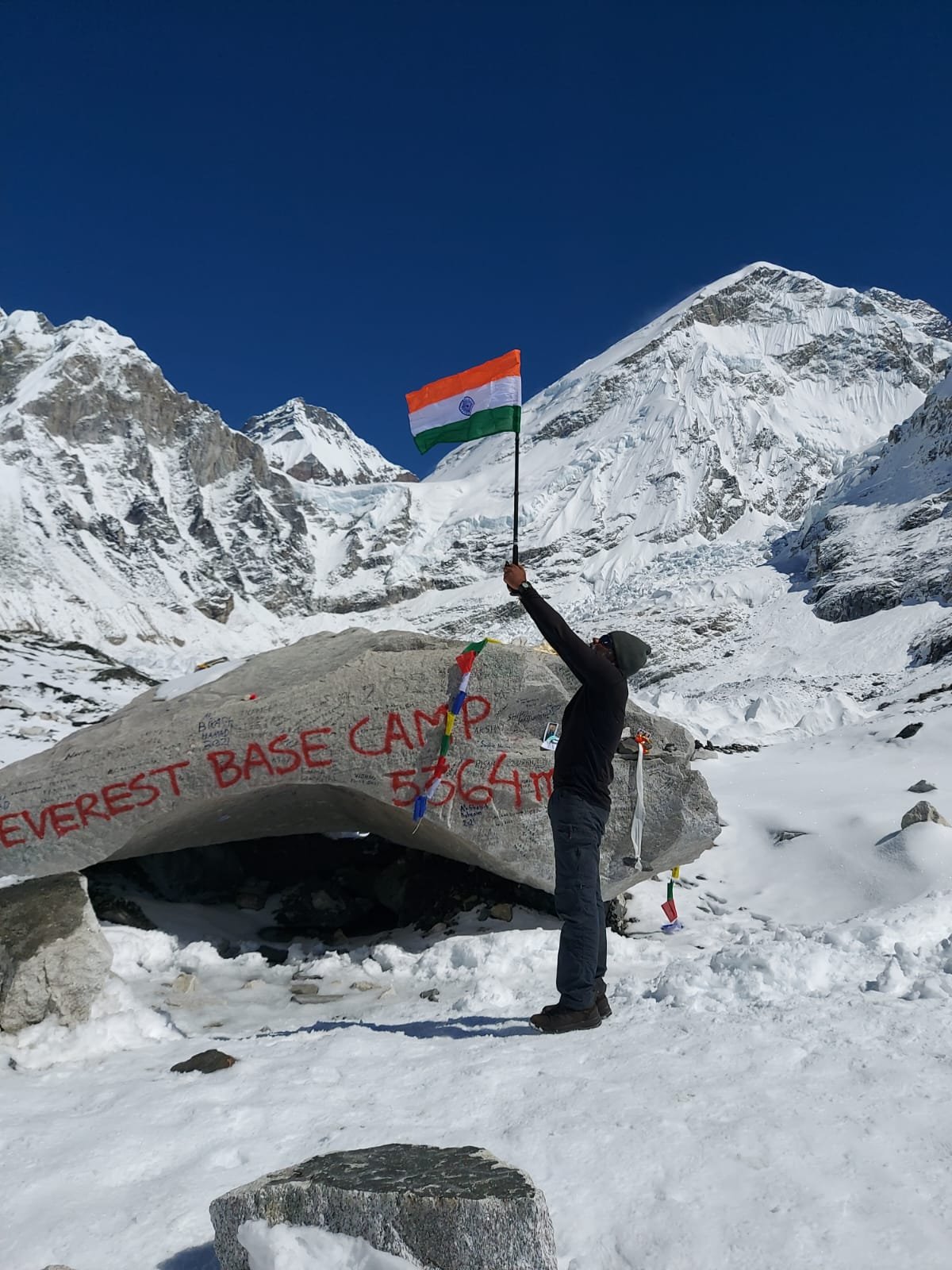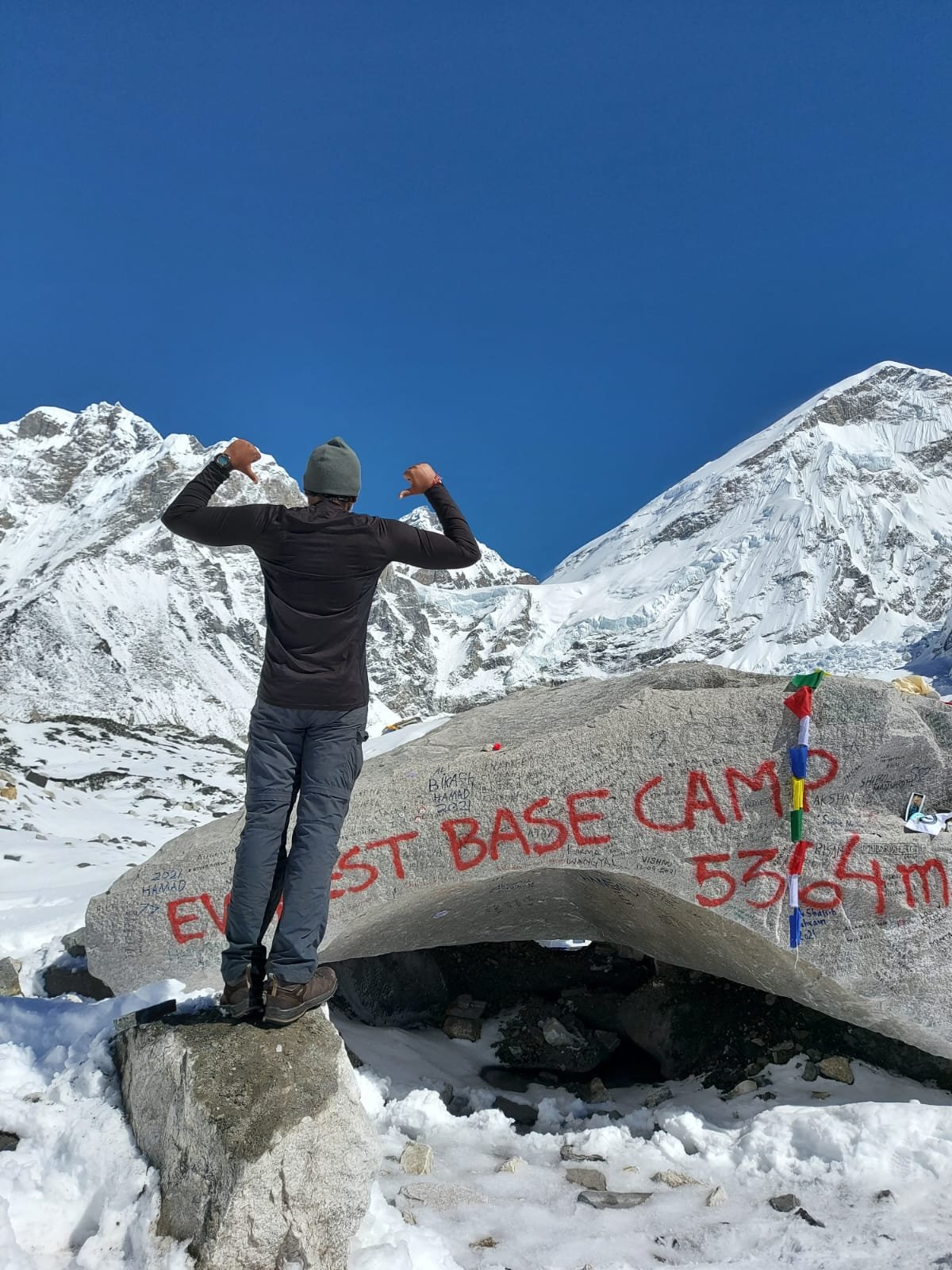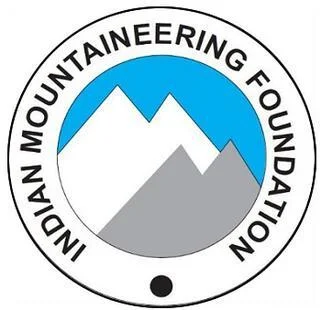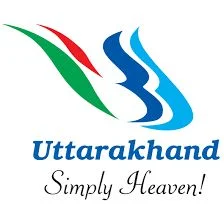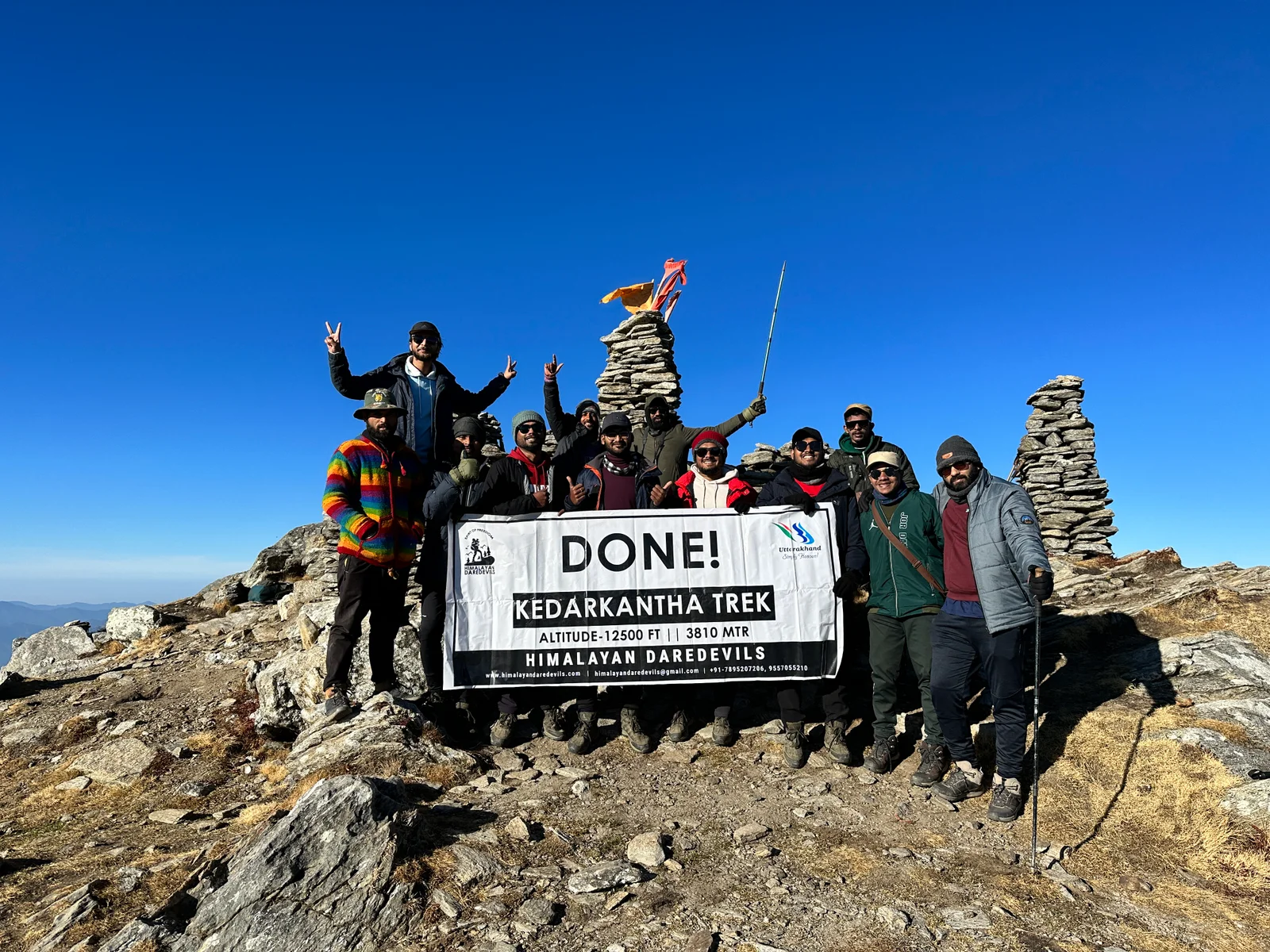Starting From
111,550
97,000.00
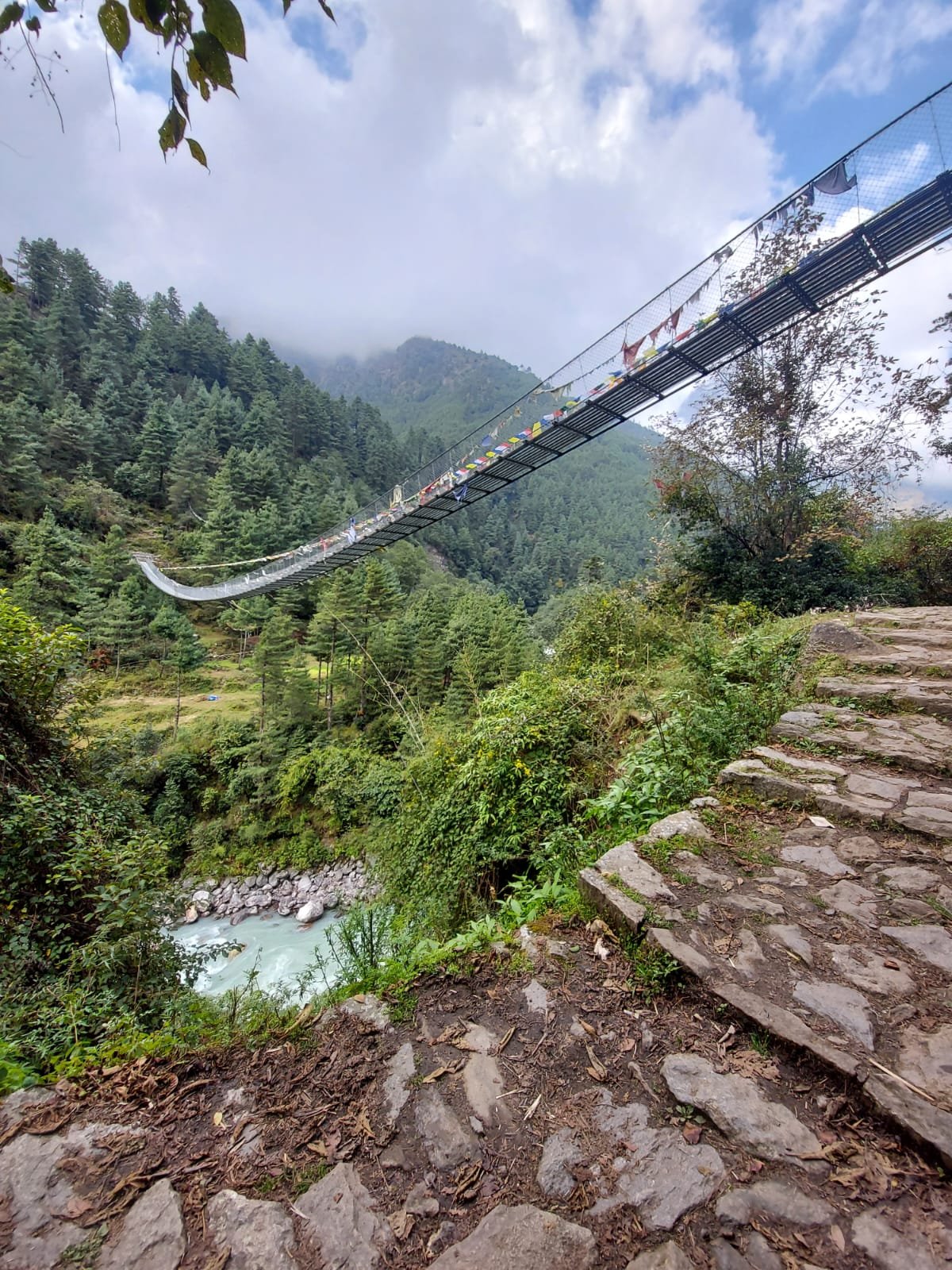
Starting From
111,550
97,000.00
Starting From
111,550
97,000.00
Everest Base Camp Trek (316+ Reviews)
One way Trek. The Trek starts and end at Lukla
Kathmandu is not connected to any railways
Kathmandu ( Tribhuvan International Airport)
Kathmandu
Summer Trek (Mid April- June) Autumn Trek (Sep-Mid Nov)
Lukla to Lukla
Veg
Homestay/ Tea houses
Nepal
13 Days
Difficult
18200 Ft
110 Km
Overview
The North Base Camp in Tibet and the South Base Camp in Nepal are the two base camps for Everest treks. The terminus of this fabled walk is the Nepalese camp in the Khumbu area, which is commonly referred to as Everest Base Camp in Nepal. It's hidden away at the end of a lengthy valley that splits at the Sherpa settlement of Dingboche and cuts into the Himalayas. Right outside the camp, the difficult Khumbu Icefall, the first challenge for anyone trying an Everest summit push, starts to ascend to the Western Cwm, the peaks of Lhotse and Nuptse, also known as the Valley of Silence.
Itinerary
The first day is set aside for travel to Nepal’s busy metropolis of Kathmandu. Its vibrant, congested alleys filled with shops piled high with climbing and trekking equipment, together with the numerous tourist hotels and cafés with tall mountains in the background, are enough to imply that hiking in Nepal will be an entirely unique experience. This location is your best bet if you need to buy some top-notch equipment, at the best prices, for your future climbs or if you are missing something for the one you are on right now! Crowds from all over the world are sifting through the city in search of climbing gear suited for the highest mountains!While Indian currency is accepted at Kathmandu’s stores and cafés, you might wish to use this day to convert your money into Nepali rupees as the upper portions of the trek only accept cash, and the only currency accepted in the tea houses above is the local currency.
-
Duration: 35 min (flight to Lukla) + 3 hours (trek to Phakding):
Distance: 7 km trek
We take a quick flight up to the trailhead before starting the walk on this day. Proceed to Tribhuvan Domestic Airport in Kathmandu after breakfast to catch our aircraft to Lukla. One of the highlights of this walk might easily be the 35-minute fly over the mountains in the Khumbu Region, which offers some of the most beautiful views in Nepal. The view out the window on these little planes is something you won’t soon forget if you score a seat on the left side. Only flights or foot travel are available to get to Lukla, a little town without a road.The first day of hiking must be formally started by walking directly from the airport across the village’s cobblestone sidewalk and into the woodland route. You must produce the first of our two permits at the checkpoint just before leaving the settlement, so have them close at hand. Today’s hike is straightforward; it lasts for three hours and begins with a 300-meter descent before gradually ascending 100 metres to reach Phakding, the overnight rest stop. Numerous mani walls painted on the trail’s rock walls and boulders with Tibetan Buddhist prayer inscriptions must be passed along the route. Along the route, there are a lot of prayer wheels as well. The first night of their trek, tourists will stay at a tea house in Phakding.
-
Duration: 6-7 hours, Distance: 11 km
From now on, it’s business as usual because today is the first day of this trek’s encounters with challenging terrain. The Dudh Kosi will be your first major river to cross, and you’ll do it twice on the tall suspension bridges that make Everest Base Camp Nepal treks so well-known. The route follows the river and repeatedly crosses the distinctive local Buddhist stones as it ascends and descends in short, repetitive steps. The hamlet of Monjo, which serves as the entrance to Sagarmatha National Park, is where you will make a lunch break. You should now hand over the second of our two licences. As you exit the park, you descend down a large wall covered in Tibetan prayers painted to the sky to the Bhote Kosi River and Jorsalle hamlet. The fun really starts here. The route becomes higher and passes through lush woodlands after one more promenade along the riverbed that resembles a beach. You eventually cross the last suspension bridge of the day, which hangs breathtakingly high over a gorge that is rapidly narrowing. From here, you must climb 600M through a densely wooded area to reach Namche Bazaar, the commercial and administrative centre of the Khumbu district. At the rest stop along the journey, if the weather is clear, you could catch your first glimpse of Everest. Tea house accommodation for the night in Namche Bazaar.
-
Acclimatization day| Explore Namche bazaar
-
Duration: 6-7 hours, Distance: 10-11 km
At 3,860 metres above sea level, Tengboche is a tiny valley. We begin our picturesque journey between the two towns by travelling through Namche on a road built with stones that runs alongside a creek. The panorama is dominated by Thamserku, a stunning peak rising to 6,608 metres, with Ama Dablam, one of the strangest-shaped mountains, farther up the valley. The south faces of Lhotse and Nuptse, which narrow the valley in front of you, meet at a ridge, and Everest is visible above it. The track consists of brief ascents and brief descents, just long enough for you to catch your breath before the next short ascent. By midday, you will arrive at your stop-hold for the day.
-
Duration: 5-6 hours
You’ll set out for your trip this morning early, cross the ridge to the other side, and then immediately enter a birch and rhododendron woodland. Lower Pangboche is around 4 km away from here; with a rise in elevation of about 260M, you should be there in less than 2 hours. The sprawling settlement of Pangboche is located just under the majestic Ama Dablam and provides some of the most breathtaking views of the mountain, making it the ideal place to stop for a rest. You either pause for tea or go right to lunch, depending on what time you arrive. From this point on, Everest is no longer visible until you reach the high reaches of the Khumbu Valley. Throughout your hike today, you will pass by several renowned peaks; don’t forget to ask your local guide about them whenever you spot a new peak peeking out from behind at a change in the scenery. The Lobuche River is on your left. After passing across several moraines, Dingboche may be seen. The south face of Lhotse (8,516 metres), which dominates the view, is one of the magnificent sites this huge community has to offer. Don’t forget to watch the sunset from this lovely spot.
-
Over the past few days, you have ascended more than 2000 metres. This is a good time to take a break so that you may relax your body and allow it time to adjust to the increased elevation. It is now more equipped to manage the elevation it will encounter in the following days. The best and most effective way to acclimatise at this altitude is to expose oneself to the mountain air, so don’t forget to get some fresh air. In this area, there is a lot to see and enjoy. From here, you may take a short journey to reach three of the highest mountain peaks in the world: Mount Lhotse, Mount Makalu, and Mount Cho Oyu.
-
Trek Distance : 7 Km Duration : 6 hours
On the 8th day of the trek to Everest Base Camp, you will travel from Dingboche to Lobuche, the second-highest village along the trail. During this day, you will have the opportunity to witness the renowned Khumbu Glacier as you walk alongside it for a significant portion of the journey. To begin the trek to Lobuche, you will follow the path behind Dingboche village, on the left side of town, which is the same route as the previous day’s ascent to Nangkartshang Peak if you choose to take that path.
-
Duration: 7 – 8 hours
Up to Gorakshep, the path features several ups and downs, the majority of which are humps on the iconic Khumbu Glacier’s moraines. After eating once you get in Gorakshep, you will immediately go to travel to Everest Base Camp, which is located at the start of the enormous Khumbu Glacier. The route follows a glacier with breathtaking views of Mounts Pumori and Nuptse to your right and left, respectively. From the base camp, you get a clear-as-day view of the Khumbu icefall, which should motivate you to improve your trekking skills. The experience of being surrounded by giants is almost unbelievable as you come face to face with some of the largest mountains in Everest Base Camp Nepal and the entire globe during this part of the journey. To reach Everest Base Camp, you must briefly trek on the Khumbu glacier, which gives you a small taste of what it must be like to ascend this enormous mountain. Before returning to Gorakshep on the same path, you will spend some time at the base camp taking in the scenery.
-
To fully experience the Everest Base Camp trek, it is essential to include a visit to Kala Patthar (also known as Kalapathar). Standing at a height of 18,176 feet / 5,540 meters, this peak looms above the quaint village of Gorak Shep and offers unparalleled panoramic views of Mount Everest within Sagarmatha National Park.
Just beyond the hamlet of Gorak Shep, a serpentine path ascends the rugged mountain known as Kala Patthar, or “black rock” in translation. This mountain offers one of the most breathtaking vistas in the entire Mount Everest Base Camp trek.From Gorakshep, it takes around 3 hours to go to Kala Patthar. Since there is nothing to stop the violent gusts, it is impossible to spend much time on the summit.
The only way to get to Pheriche from Kala Patthar is to descend. It should take roughly 4 hours to descend over 1,300 metres. On the Dhudhkoshi River’s bank, in a level valley, is the town of Pheriche.
-
This morning the trail will pass through river, birch, and rhododendron forests to Tengboche. As you trek down the trail, you will see majestic mountain ranges. Everest, Lhotse, Kantege, Kwangde, Nuputse, Tawache, Ama Dablam, and Thamserku are a few of the Himalayan giants to be seen on the way. The trek will be downwards from Tengboche to the Dudh Kosi bridge. When you reach Phunki Tenga, you will witness water-driven prayer wheels before reaching Namche camp.
-
On the last day of the trek, the trail will follow from Dudh Kosi down to Lukla. And through Phkading and passing through the lush green forest, you will reach Lukla. In the evening, the Trekup India team plans a celebration to celebrate the trek with the trekker. You will get to party with sherpa guides and porters who will show some steps of the Sherpa dance, and you can also try chang (local beer). It will be the most fitting way to end an adventurous and fantastic trip.
-
Today well in time as per the flight schedule we will drive to airport and board the same to Ramechap/Kathmandu. Arrival meets and receives by company representative and drives to booked hotel. Evening followed by a farewell Dinner and certificate ceremony.
Everest Base Camp Trek Map
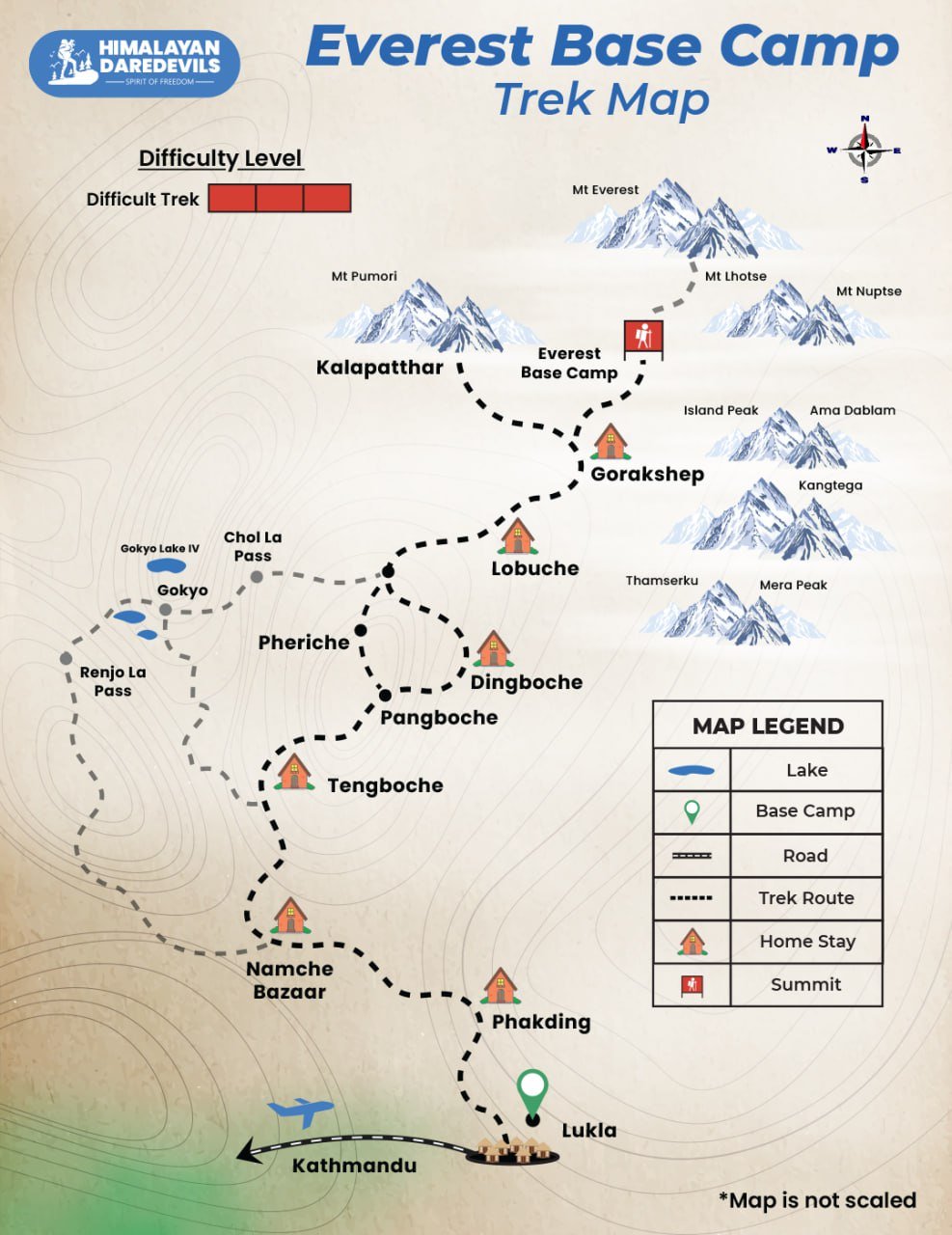
Inclusions
Exclusions
- Accommodation ● Day 2 and Day 13 you will be staying in Tea-House
- Team ● Certified English Speaking Guide ● Assistant Guide and other staff
- Meals ● All meals from Day 2 ( dinner ) Lukla to Day 13 ( Breakfast ) Lukla
- Medical Facility ● First aid medical kit and oxygen cylinder
- All Permits ● Khumbu Municipality Fees
- Service from Lukla to Lukla
- Trek Completion Certificate
- All optional additional tours or activities during free time
- Porters for the personal bag
- Phone charging, Charging batteries, hot showers
- International or National Air Fare
- Visas
- 5% GST
- Travel Insurance
- Tips
- Any kind of personal expenses.
- Food during the transit.
- Transport
- Any kind of emergency evacuation charges
- Any expense incurred or loss cost by reasons beyond our control such as bad weather, natural calamities (landslides, floods), flight delays/rescheduling/ cancellations, any accidents/medical evacuations, riots/strikes/war/pandemics etc.
- Anything not specifically mentioned under the head.
- Accommodation ● Day 2 and Day 13 you will be staying in Tea-House
- Team ● Certified English Speaking Guide ● Assistant Guide and other staff
- Meals ● All meals from Day 2 ( dinner ) Lukla to Day 13 ( Breakfast ) Lukla
- Medical Facility ● First aid medical kit and oxygen cylinder
- All Permits ● Khumbu Municipality Fees
- Service from Lukla to Lukla
- Trek Completion Certificate
- All optional additional tours or activities during free time
- Porters for the personal bag
- Phone charging, Charging batteries, hot showers
- International or National Air Fare
- Visas
- 5% GST
- Travel Insurance
- Tips
- Any kind of personal expenses.
- Food during the transit.
- Transport
- Any kind of emergency evacuation charges
- Any expense incurred or loss cost by reasons beyond our control such as bad weather, natural calamities (landslides, floods), flight delays/rescheduling/ cancellations, any accidents/medical evacuations, riots/strikes/war/pandemics etc.
- Anything not specifically mentioned under the head.
What to carry
- Trekking shoes: A good pair of trekking shoes is essential for a comfortable and safe trek. Look for shoes that are sturdy, provide good ankle support, and have a good grip on different types of terrain.
- Backpack with rain cover (50-60 ltr): A backpack is necessary to carry all your gear. Make sure it's the right size for your trek, and comes with a rain cover to keep your belongings dry in case of rain.
- Thermals (upper and lower): Thermals are lightweight and comfortable base layers that help regulate your body temperature in cold weather. Bring both upper and lower thermals to keep warm.
- 3 T-shirts (advisable quick dry): Choose quick-drying T-shirts made from breathable and moisture-wicking materials. This will help keep you cool and dry during your trek.
- 2 trek pants: Choose lightweight and comfortable trek pants that are easy to move in and can dry quickly if wet.
- Jacket (-10 degrees): A warm jacket is essential for cold weather. Choose a jacket that is waterproof and windproof, and provides good insulation.
- Fleece or hood (2): Fleece jackets or hoodies are great mid-layer options to keep warm. Bring at least two, as they can also be used as an extra layer at night.
- Sunglasses (UV protected): Protect your eyes from the sun's harmful UV rays with sunglasses that are designed for outdoor activities.
- Sun cap: A sun cap or hat with a brim will protect your face and neck from the sun.
- Hand gloves: Bring a pair of lightweight gloves to keep your hands warm and protected from wind and sunburn.
- Woolen cap: A woolen cap will keep your head and ears warm at night or in cold weather.
- Socks (3 pairs min): Bring at least three pairs of good quality socks that are moisture-wicking and provide good cushioning and support for your feet.
- Headlamp: A headlamp will come in handy if you're hiking in low-light conditions or need to find your way in the dark.
- Trekking pole (if needed): Trekking poles can help reduce strain on your legs and provide additional support on steep terrain.
- Rain cover\poncho: A rain cover or poncho will keep you and your gear dry during unexpected rain showers.
- Day pack (if you plan to offload your bag): If you plan to offload your backpack during the trek, bring a smaller day pack to carry essentials like water, snacks, and a first aid kit.
- A toiletry kit: Bring a small kit with personal hygiene items, such as a toothbrush and toothpaste, wet wipes, hand sanitizer, and toilet paper.
- Lunchbox, cup, spoon: If you plan to bring your own food, bring a lunchbox, cup, and spoon to carry and eat your meals.
- 2 one-litter bottles: Staying hydrated is crucial, so bring at least two one-liter bottles to carry water.
- 2-3 plastic covers to keep your wet or used clothes: Plastic bags are useful for keeping wet or dirty clothes separate from the rest of your belongings. They can also be used to pack out any trash or waste you generate during the trek.
How to reach
Planning your onward flight/train booking
If you are travelling from India or any other country, book your flight tickets for Day Minus One, which is two days before Day 1 on the itinerary. If your trek start day is 15 September, book your air tickets for 13 September to either Kathmandu on 14 September to Lukla.
Option 1: Fly to Kathmandu and then fly to Lukla
This is the quickest way to reach Lukla. Take a flight to Kathmandu and then another flight to Lukla.
Lukla is a small town with an airstrip that drops off to the valley. There are daily flights in the morning from Kathmandu to Lukla. Flights into Lukla are highly weather-dependent. A cloud covering a mountain ridge can shut down the entire airport! This is why you must book the first flight out of Kathmandu and factor in buffer days in the itinerary.
Tip: If you are reaching Kathmandu early on Day Minus One, you can think of taking a flight on the same day as well. We have seen the notorious airport of Lukla where trekkers have missed flights for two straight days because of weather conditions. This will give you two buffer days in case there is any delay.
Reaching Lukla early will give time for your body to acclimatise better as well.
Option 2: Fly to Kathmandu and then fly to Lukla via Ramechhap
In case a flight from Kathmandu to Luka isn’t working out, your other option to Lukla will be to take a flight from Manthali airport, which is close to Ramechhap.
Take a regular shared cab or bus from Kathmandu to Ramechhap. The duration of the drive is between 5-7 hours. And these modes of transport are almost always available in trekking season.
Tip: The best way is to take a shared Cab from New Bus Park Kathmandu, which cost NPR 500, is much more comfortable than a bus and moves after every one hour.
Option 3: Trek to Lukla on your own
Take this option if you are reaching out more than a week in advance to Kathmandu.
The trek starts from a small village called Jiri which is 7-8 hrs of bus journey from Kathmandu. It is an astounding distance of 56 km and can take anywhere between 4 days to 7 days to reach Lukla.
Again, do this only if you have a lot of time in hand and the required experience and fitness to be able to trek for 16 days after this.
Planning your return flight/train booking
The trek ends at Lukla on Day 17 including a buffer day.
For your return journey, you can again fly back from Lukla to Kathmandu. Or you could fly via Ramechhap.
Taking into account the buffer day: Booking your return tickets requires some thought. First, always book your return ticket keeping in mind the buffer day. The buffer day must be included in your itinerary. If your trek ends on Day 16 do not book your flight/bus tickets for Day 16. Instead, book for Day 17. Day 17 is your buffer day.
Planning your hotel/stay
While booking hotels on your return, always assume book your rooms assuming the buffer day is not being used. Assume the trek is going to run without any hiccups. So what happens if you use your buffer day on the trek? Unfortunately, then you’ll probably lose your hotel booking.
So book hotels where you may not have to transfer money in advance. Even if you do, consider it better than missing out on the trek. In Kathmandu, it is not difficult to find last minute hotel bookings if in case the buffer day is used.
Fitness and preparation guide for Everest Base Camp Trek
FAQ
The Everest Base Camp Nepal Trip is possibly the most well-known trek in Asia, and possibly the whole globe. The path has recently seen congestion and some pollution. Nothing, however, can compare to the exhilarating sense of adventure that comes with making the ascent to the very edge of the highest mountain in the world. When you get a jaw-dropping broadside of Mount Everest from a viewpoint on the south side of Ama Dablam in the early going of your journey, this reaches a fever pitch.
The trek's rewards aren't always easy to come by. Everest Base Camp Nepal is a high-altitude route that takes a significant amount of time to acclimatize to. The 80-mile (130-km) journey from Lukla usually takes 12–14 days of intense trekking (yes, even your "rest days" require walking!). However, the reason the entire journey takes so many days is that it needs to be broken down into manageable portions owing to the altitude, with acclimatization and rest days thrown in. The majority of itineraries allow enough time to finish each leg in a single day at a speed significantly slower than the standard trekking pace.
Pre- and post-monsoon, or March–May and October–November, respectively, are the two primary trekking seasons to reach Everest Base Camp. It is also feasible to go outside of these months; however, owing to the weather, these would be the busiest seasons. It starts chilly and grows warmer from March to May, and the opposite is true after the monsoon.
As it is a once-in-a-lifetime opportunity, everyone must go on this trek. There are some stunning views of the Himalayas that you will not find anywhere else. Another reason for taking this trek is spirituality, as there are various beautiful monasteries like Tengboche Monastery. You have the opportunity to take a flight along the hills because the airport is located in Lukla. You get to enjoy the sightseeing experience of Sagarmatha National Park which is a UNESCO world heritage site. There you can see animals like snow leopards, Himalayan goats & eagles, and blue sheep.
Cancellation policy
Life is unpredictable and we understand sometimes you have to cancel or change your trip dates and it is our endeavour to make it as easy possible for you. However, please understand we plan everything including guide fees, permits, accommodation and ration in advance. Therefore any cancellation means inconvenience and certain losses to the people involved in various stages of programme. Keeping that in mind, our cancellation charges are as below-
Cancellation prior to 30 days from start of the event: Get monetary refund with 15% of cancellation charges on trek fee.
Cancellation between 30 days and 15 days to the start of event: 50% on trek fee is non refundable and the remaining 50 % will be given as cash voucher which is valid for 1 year.
Cancellation less than 15 days to the start of event: No refund.
Please note cancellation will be only accepted by email.
Booking amount is non refundable
Note: The Himalayan Daredevils reserves the right to cancel a programme before departure in the event of logistical problems arriving due to natural calamities, strikes, wars on any other circumstances that makes the event inadvisable. In this case, 50% on trek fee is non refundable and the remaining 50 % will be given as cash voucher which is valid for 1 year.
Itinerary changes & trip delays:
We plan itineraries based on the information at the time of planning and in rare circumstances, there are subject to change. In the event that the itinerary is changes or delayed due to unforeseen circumstances such as bad weather conditions, transportation delays, government intervention, landslides etc. We will always aim to give you the best experience possible. However The Himalayan Daredevils are not be held responsible for the cost of delay or changes.
Why Choose Us
